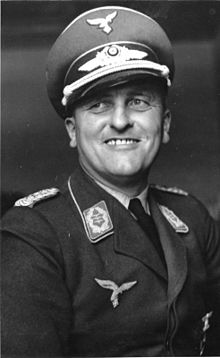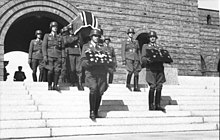Günther Korten
This article needs additional citations for verification. (June 2016) |
Günther Korten | |
|---|---|
 | |
| Born | 26 July 1898 Cologne, German Empire |
| Died | 22 July 1944 (aged 45) Carlshof, Rastenburg, East Prussia, Nazi Germany |
| Allegiance | |
| Service/ | |
| Years of service | 1914–44 |
| Rank | |
| Commands held | Chief of the Luftwaffe General Staff |
| Battles/wars | World War I
World War II |
| Awards | Knight's Cross of the Iron Cross |
Günther Korten (26 July 1898 – 22 July 1944) was a German
Biography
Early life
Korten was born in
World War II
Korten, by then a captain, joined the Luftwaffe in 1934 as Nazi Germany started on its rearmament programme. He received training as a general staff officer and served for several years in the Air Ministry. He was a colonel and chief of the general staff of Luftflotte 4 (4th Air Fleet) stationed in Austria.
At the beginning of 1940, Korten was transferred to the general staff of the
At the beginning of 1943 Korten was promoted to general and in the summer replaced Alfred Keller at Luftflotte 1 (1st Air Fleet). A few weeks later, on 25 August he accepted the position of chief of the general staff of the Luftwaffe, after the former chief of the general staff Hans Jeschonnek committed suicide.
Death


Korten was seriously wounded in the
Originally, Korten was buried in the Tannenberg Memorial.[2] The memorial complex was demolished following the war, and he was reburied in the Friedhof Bergstraße cemetery in Steglitz, Berlin. The grave still exists.
Awards
- Iron Cross (1914), 2nd and 1st Class
- Clasp to the Iron Cross (1939), 2nd and 1st Class
- Honour Cross of the World War 1914/1918
- Pilot/Observer Badge In Gold with Diamonds
- German Cross in Gold (29 December 1942)[3]
- Knight's Cross of the Iron Cross on 3 May 1941 as Generalmajor and Chief of the General Staff of Luftflotte 4[4]
- Wound Badge of 20 July (posthumously)
References
Citations
- ISBN 978-3-73251-373-4.
- YouTube)
- ^ Patzwall
- ^ Scherzer 2007, p. 467.
Bibliography
- Patzwall, Klaus D.; Scherzer, Veit (2001). Das Deutsche Kreuz 1941 – 1945 Geschichte und Inhaber Band II [The German Cross 1941 – 1945 History and Recipients Volume 2] (in German). Norderstedt, Germany: Verlag Klaus D. Patzwall. ISBN 978-3-931533-45-8.
- Scherzer, Veit (2007). Die Ritterkreuzträger 1939–1945 Die Inhaber des Ritterkreuzes des Eisernen Kreuzes 1939 von Heer, Luftwaffe, Kriegsmarine, Waffen-SS, Volkssturm sowie mit Deutschland verbündeter Streitkräfte nach den Unterlagen des Bundesarchives [The Knight's Cross Bearers 1939–1945 The Holders of the Knight's Cross of the Iron Cross 1939 by Army, Air Force, Navy, Waffen-SS, Volkssturm and Allied Forces with Germany According to the Documents of the Federal Archives] (in German). Jena, Germany: Scherzers Militaer-Verlag. ISBN 978-3-938845-17-2.
